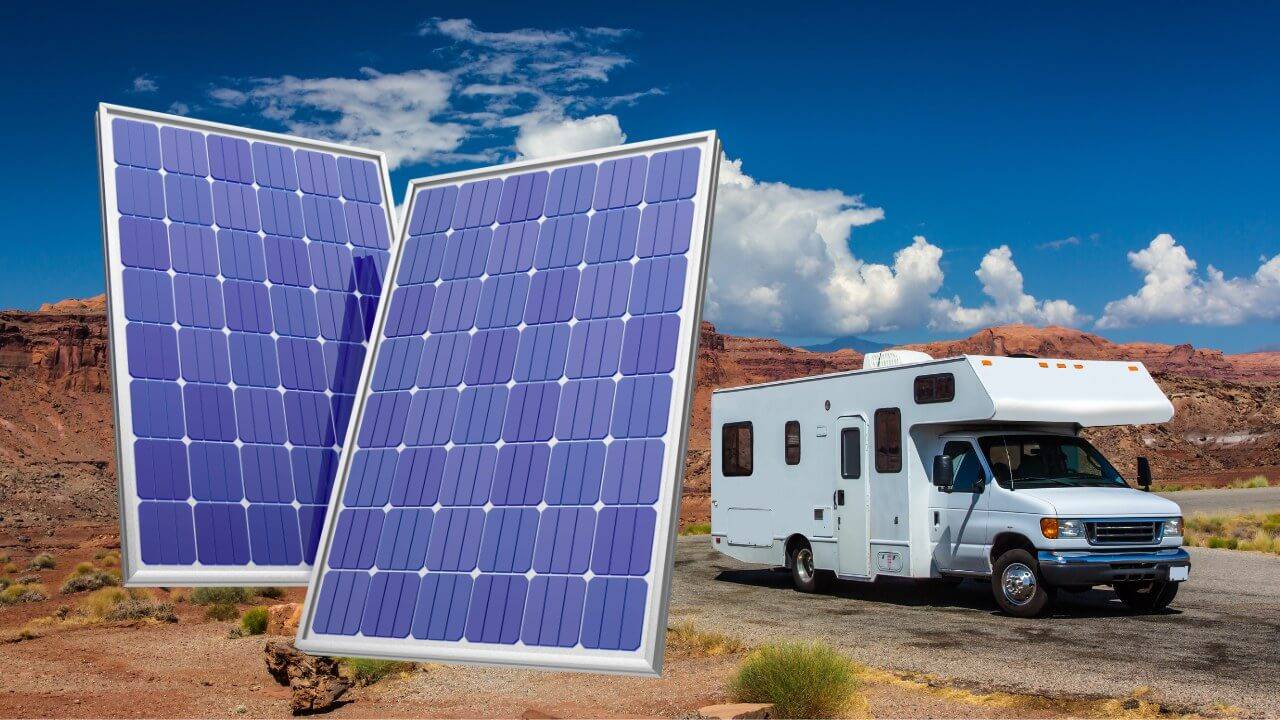When I first saw solar panels slapped on an RV I immediately thought of one of my all-time childhood movies “Race the Sun.” It’s about teenagers who build their solar car to race across Australia.
Now, as a camping and RVing enthusiast, I realize that solar panels can’t power the RV but can make my trip much more convenient and sustainable.
But what sort of problems will solar panels solve in your RV?
Coupled with a capable solar battery, I use them to power the appliances and lighting in my RV. This allows me to camp away from crowded campsites and become fully independent of the grid.
What is more, it allows me to camp sustainably and offset the carbon emissions of my RV by using a renewable source of electricity.
What Are RV Solar Panels?
RV solar panels are similar to home solar panels. But instead of powering your home, they use the power of the sun to charge your RV battery.
When your RV is on the road or parked in a sunny spot, the solar panels on the roof absorb energy from the sun.
Then you can use the RV battery to power lights and small appliances in your camper.
If you add more batteries that the solar panels can charge, you have more electricity available when camping.
Do You Need To Use RV-Specific Solar Panels?
Whatever vendors want you to believe, there is no such thing as solar panels that are strictly for RV use. Many companies market their products as RV solar panels but only because those panels are suitable for RV use.
These include both portable solar panels which have multiple ways of permanent or semi-permanent attaching to your RV roof as well as flexible solar panels that you can fix to curved surfaces. Flexible solar panels are a bigger investment but provide a higher ROI with high-efficiency rates.
I also want to say that solar panels are not a magic pill.
Not so Free Energy
This “free” and clean power sounds much better than the fuel generator.
But when I say free I mean the sunshine. The hardware can be quite expensive. Sure, prices of solar equipment have gotten a bit more reasonable in recent years, but if you want quality, you still need to pay a hefty sum.
You need a couple of pairs of 100-watt panels and deep-cycle solar batteries to store power and charge the controller that keeps them from overcharging. Then there’s the inverter that turns the DC power into AC power that most appliances use.
When you add those up, you can be looking at a $1,500+ investment up front.
Also, collecting solar power is much more complicated than hooking up to shore power at a campsite. You need to know how much power you’ll need on a daily basis and size your system accordingly.
No Shade Where I’m Going
It also means you’ll have to park in full sunshine for most of the day. In other words, you can forget about parking your RV in a nicely shaded campsite where you can throw a barbie and pass a few cold ones.
Don’t get me wrong, solar power is great and worth the investment, especially if you like to boondock on public land away from the grid.
It’s just that for the most part, if you want the maximum power, you need to:
- Open your wallet
- Leave your rig in the blistering hot sun
How Much Energy Do You Need for an RV?
First, you need to know how much energy you use in your RV in a day. There are two ways to do this. The first one is easier and the second one is free.
1. Use a battery meter
The easiest way to tell your daily consumption is to install a battery meter like this Renogy 500A Battery Monitor. Before installing solar panels, go camping without hookup charging along the way and the monitor will give you the amount of energy you use with ±1% accuracy.
2. Calculate your energy use
This way is 100% but requires a bit of math and planning. In short, you need to find out what each appliance or device in your RV consumes and multiply that by the number of hours you expect to use it.
For example, you have one TV that consumes 100 watts. You guess that you’ll watch TV for about 2 hours per day. So 100W x 2h = 200Wh a day.
You can do the same for every electrical device you want to power while you’re boondocking and you’ll get a rough estimate of the total watt-hours you need. Add a 20% for safety and from there you can estimate how many panels you need.
If you plan to cook outside and only use electricity for things like lighting, TV, and charging your phone or laptop, two or three 100W solar panels and a 1,200Wh battery will do.
However, if you want to power your fridge or AC you’ll need more panels and batteries.
How Many Solar Panels Do I Need For My RV?
Now when you’ve measured or calculated the amount of energy you need daily, there is one more thing to consider:
How much energy do solar panels provide to your battery?
You need to achieve a balance here.
Install too many solar panels without enough battery storage and you’re wasting both money and energy that can’t be stored nor used.
On the other hand, slap one solar panel and a row of batteries, and you won’t be able to charge them all while the sun’s up.
Let’s now calculate energy generation and storage needs.
For example, a high-end 100W solar panel will generate an average of 350Wh per day. Keep in mind that this varies by location and time of year.
You also need to know how many batteries you need to store the power that your RV solar panels generate. One 100Ah 12V battery has about 1,200Wh storage capacity.
I say it again: Your solar panels for RV will only give you the listed number of watts under perfect conditions.
Perfect conditions = direct sun shining directly at the panel
On a rainy day, you’ll be lucky to get 100 watt-hours from your 100W solar panels. The same goes for parking in the shade.
It’s also challenging to estimate the amount of energy you’ll use in a day because days are different. One day you might be outside from dawn to dusk, enjoying nature, hiking, canoeing, and whatnot. The next day might be rainy and you’ll stay inside your RV working on your laptop or watching TV for hours in the evening.
So whatever you do, estimate high.
How Much Do RV Solar Panels Cost?
How much your RV solar panel system will cost depends on what you expect from your solar system. Setting up your RV with solar power is not a cheap project.
On the bright side, there are great solar panels for RV that are available at any price point.
Weekend RVers — Solar System Around $1,000
If you mainly use your RV over the weekend, you most certainly don’t need a solar system that can power a house.
In that case, I recommend buying a solar system that will allow you to use the sun to charge phones, turn on the lights, and power a few outlets.
If you’re not confident about using your RV’s original wiring, you can pair your solar panels with a solar generator that already has multiple outlets for both 110V and 12V power.
Solar generators already have a battery and inverter inside, so you only need to plug in the appropriate solar panels for RV.
Hardcore RVers
If you like to spend several weeks traveling in your RV, I recommend you build a more capable RV solar system.
Higher-end components are better built which leads to fewer maintenance issues. Manufacturers often offer RV solar panel kits that contain everything you need to build a full-fledged solar system for your RV.
For example, the Renogy 800W 12V/24V Monocrystalline Solar Premium Kit costs $1,399.99 and includes eight 100-watt solar panels and a Rover 60A MPPT Charge Controller.
But then you also need an inverter like this Renogy 1000W 12V Pure Sine Wave Inverter for $254.99.
And you need a deep cycle discharge battery. If you want to make the most out of those 3.4 or 4 hours that the sun is directly above, you’ll need at least a 2,000Wh battery. For example, this Renogy 12V 200Ah Lithium Iron Phosphate Battery costs $1,129.
How to Install Solar Panels on Your RV
Now let’s take a look at how to set up RV solar panels in the simplest possible way.
For starters, a solar system for RV has a few basic components:
- Solar panels for RV
- Charge controller
- Solar battery
- Battery monitor with a shunt
- Fuses and breakers
- Wires
And that’s it.
But how do you hook up solar panels to RV batteries?
You can’t charge the RV battery with solar panels directly. First, you need to hook solar panels to a charge controller and put a battery monitor in between the controller and the RV battery.
It might sound complicated but it isn’t.
Let’s begin with the RV solar panel installation.
Step 1: How to Mount Solar Panels on Your RV Roof
Depending on the kit you bought, you’ll either have to use Z-brackets or screws or silicone adhesive.
If you’re going with screws, mount the brackets and set your panel where you want it, and mark the holes for drilling.
Now, this part is super important. You’ll be drilling through your RV roof so you don’t want any water to leak inside.
I used a Dicor Roof Sealant. Just apply some sealant over the markings so that when the screw goes in it pulls into that membrane and makes a watertight seal.
If you’re gluing the panels or using the tape make sure the adhesive makes a complete seal around the edges as you don’t want any moisture or dust to accumulate under your flexible solar panels.
Step 2: How to Connect the Panels
If the wires you got in the solar panel kit are too short, you can use an extra IP65-rated junction box.
From there, lead the wires into a circuit breaker. I prefer circuit breakers to fuses because I can disconnect the panels from the rest of the system with a flick of a switch.
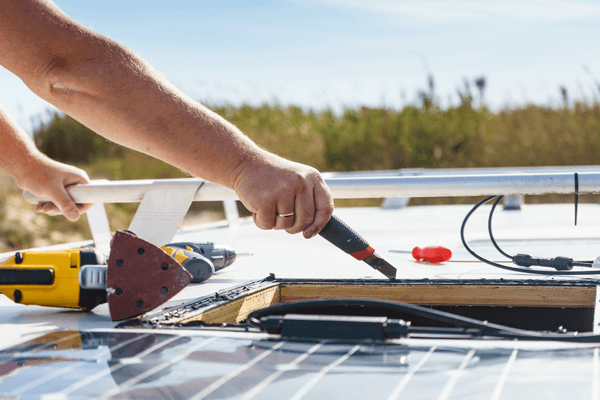
Step 3: How to Connect the Battery
Now, remember, you don’t want to hook your panels to the charge controller until you’ve hooked up the battery.
Connecting the battery is quite simple. You’ll need a fuse in between there, so from the positive side of the charge controller go to the fuse and form there to the positive side of the battery.
And on the negative side, first, lead a wire from the battery monitor shunt to the charge controller and then from the battery monitor to the negative side of the battery.
Once you hook up the charge controller to the battery, it’s going to power up the display. From there you can finish hooking up the solar panels to the charge controller and turn on that little breaker.
And that’s pretty much it. Now you can see what’s coming from solar panels into your battery.
Rigid vs. Flexible Solar Panels: Which One Is Best for RVs?
Both rigid and flexible solar panels have the same job but they are built for different applications.
Rigid Solar Panels
Usually have a metal frame and are encased in sturdy glass. This makes them much heavier, but also much more durable.
In the past, rigid solar panels were considered more efficient than their flexible counterparts. However in recent years, technology has advanced, so now they’re an equal match.
However, two things haven’t changed:
- The rigid solar panels will take up less square footage than flexible panels.
- Rigid solar panels are usually less expensive.
Finally, rigid solar panels have a less tendency to overheat. Flexible panels sit directly on the RV roof so there’s nowhere for the heat to escape. Rigid solar panels have raised mounts that allow airflow all around them.
On the downside, the mounts produce more drag on the road, which translates to more fuel spent.
Flexible Solar Panels
Flexible solar panels are much thinner and built like laminate materials so they are bendable to an extent. This makes them perfect for curved or streamlined surfaces like boat hulls, RV roofs, etc.
Since they are glued or screwed down to the RV roof they don’t create any drag while on the road.
Flexible panels also weigh much less, which makes them perfect for RV and marine use. No one wants to put more weight than they already haul around.
These perks combined make flexible solar panels for RV much easier to install on your rig. In some cases, you won’t need any tools but a tube of silicone adhesive or EternaBond tape.
Flexible solar panels are also more portable. Removing and storing rigid solar panels is much harder. I’ve never heard of anyone in my RV community doing that.
On the other hand, you can easily remove flexible panels from your RV roof to slide them into any bay for storage.
Verdict: Rigid vs. Flexible Solar Panels
If you ask me, solar panels for RV have to be either flexible or portable. Rigid solar panels are not just 70% heavier, but also require more complicated mounts, not to mention the additional drag on the road.
Are RV Solar Panels Worth It?
RV solar panels are definitely worth the investment.
Some of you will choose an inexpensive RV solar “starter pack” with a simple charge controller and a lead acid battery.
Enough for charging a few devices between shore hookups.
Or you may want full independence from the grid and splurge on 8x100W flexible solar panels + pure sine inverter and LiFePO4 battery with 3,500+ discharge cycles.
Others will go for maximum flexibility and rig up portable solar panels for RV and use a solar generator unit that is both an inverter and a battery in one.
Let’s be honest — in any case, the upfront price is higher than what you’d pay for the fuel generator.
But once you’re past the price point, everything is pure gain — both for you and the environment.
So, let me ask you this:
What price are you willing to pay to ditch the nasty exhaust fumes and harness the clean and free energy of the sun?
What Is The Best Solar Panel Brand for RV?
Renogy

Renogy has established itself as a go-to brand for RV solar power solutions, offering high-efficiency monocrystalline panels that maximize energy output in limited roof space.
Their 100-watt solar panels are a favorite among RVers due to their durability, weather resistance, and reliable performance in off-grid settings. While Renogy excels in providing energy independence on the road, their transparency regarding material sourcing and supply chain ethics remains unclear.
Still, for those seeking a long-term, road-ready solar solution, Renogy’s technology delivers a balance of performance and affordability.
Jackery
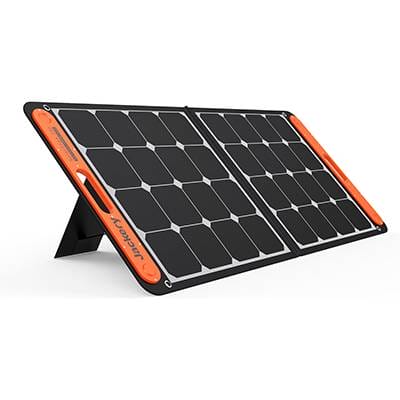
Jackery’s SolarSaga 100W panel is an excellent choice for RVers who prioritize portability and convenience.
Designed for quick deployment, these lightweight, foldable panels are ideal for travelers who prefer a plug-and-play solar setup.
While they pair well with Jackery’s portable power stations, they may not be the best fit for permanent roof-mounted RV installations. The brand actively promotes clean energy alternatives to gas generators, but it provides little information on sustainable manufacturing practices.
Despite this, Jackery makes solar power more accessible for RV owners who value ease of use over complex installations.
Bluetti
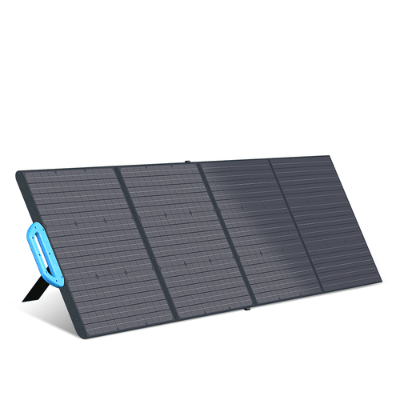
Bluetti caters to RVers looking for an efficient off-grid power solution that integrates seamlessly with their portable power stations.
Their solar panels, built for high efficiency, allow RV travelers to generate and store energy without relying on noisy, fuel-dependent generators.
However, Bluetti’s long-term sustainability remains uncertain, with little transparency about supply chain ethics or recyclability. While their panels perform well for off-grid adventurers, those looking for a more permanent, roof-mounted setup may need to explore other brands.
Still, Bluetti remains a solid option for mobile energy independence.
Ecoflow

EcoFlow’s 100-watt solar panels are built with RVers in mind, combining portability, high efficiency, and quick setup.
Their lightweight design makes them easy to move and position, making them a practical choice for RVers who prefer flexible solar solutions. The brand champions carbon footprint reduction through clean energy alternatives, but details about material sourcing and long-term recyclability are scarce.
For RV owners seeking a reliable, high-output solar panel that pairs well with portable power stations, EcoFlow offers a compelling option.
ECO-WORTHY
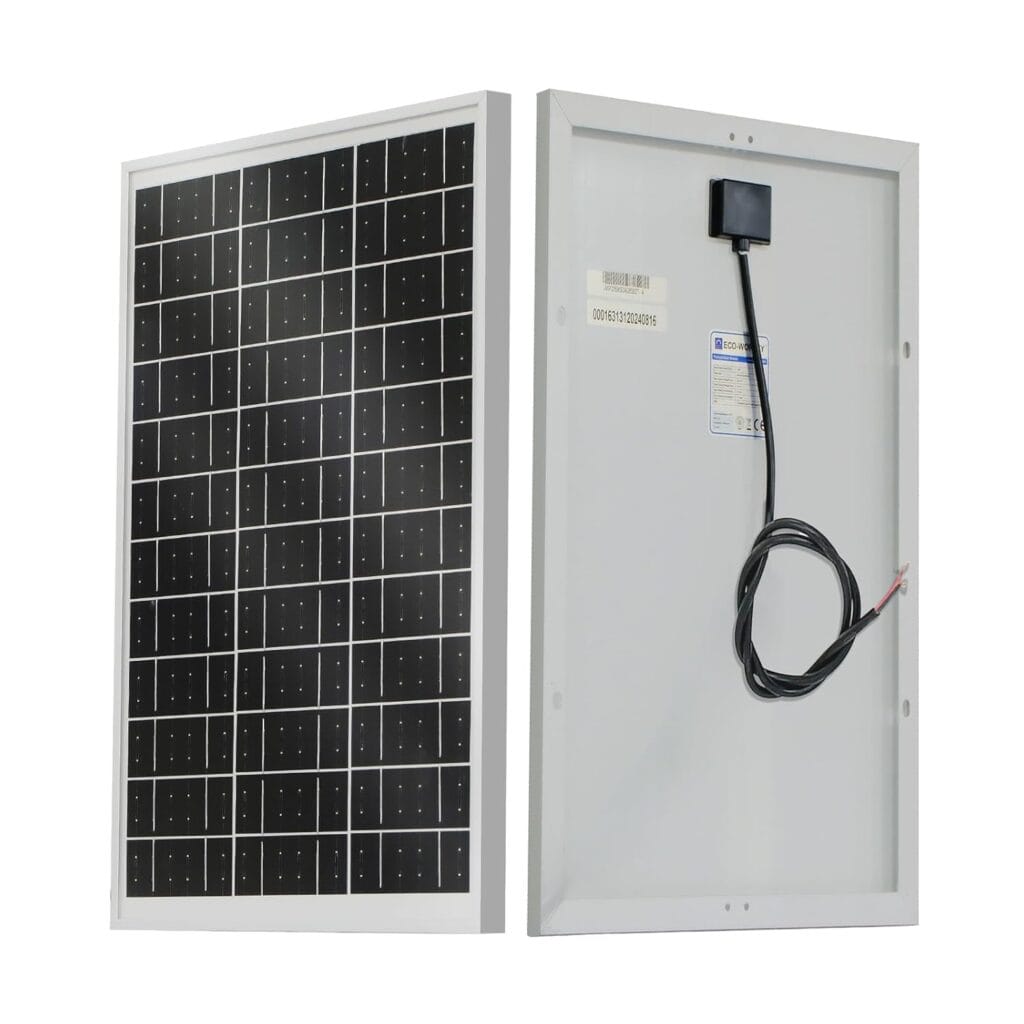
ECO-WORTHY provides budget-friendly 100-watt solar panels that cater to RVers looking for an affordable way to harness solar energy.
Their panels are well-suited for off-grid travel, but questions remain about their durability and sustainability. While the brand aims to make solar accessible, it offers little transparency about its manufacturing ethics or whether its materials are responsibly sourced.
Still, for those on a tight budget who want a basic solar setup for their RV, ECO-WORTHY provides a cost-effective entry point.
Topsolar
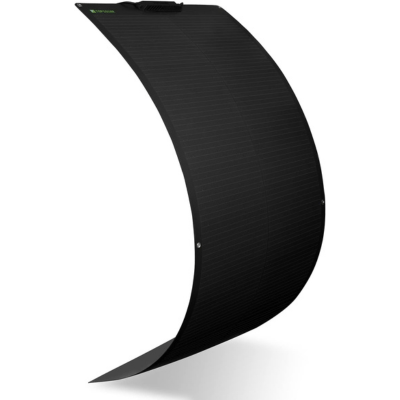
Topsolar’s 100W Flexible Solar Panel is a great option for RVers who need lightweight, bendable panels that can conform to curved surfaces.
These panels are particularly useful for smaller RVs, campervans, or those who want an easy-to-install solar solution without drilling into their roof. However, as with most budget-friendly solar panels, longevity can be a concern—Topsolar’s panels may not have the same protective coatings or lifespan as premium brands like Renogy.
Additionally, there is little available information on their sustainability practices. Still, for RVers looking to experiment with solar power without a significant investment, Topsolar is worth considering.
Conclusion
Switching to RV solar panels is more than just a trend—it’s a game-changer for off-grid travel and energy independence. Whether you need rigid or flexible panels, understanding your energy needs, installation process, and costs helps you build a system that fits your RV lifestyle. While not every traveler needs solar, the benefits—lower fuel costs, quieter camping, and sustainable power—make it worth considering. The best solar panel for your RV depends on your setup, but one thing is clear: investing in solar means more freedom on the road and less reliance on hookups. Ready to harness the sun for your next adventure?

